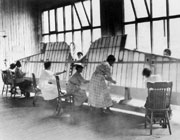FOR MORE THAN half a century, there was no escape from Boeing in the Northwest. If your dad didn’t work there, your best friend’s dad did or, rarely, his mom. Boeing and rain were the only things we were famous for, and they seemed to be all around us, all the time, in equal measure.
You’d see guys walking around in the rain wearing Boeing badges. Even little kids knew a guy with a dusky orange plastic bar across the top of his Boeing badge had a lot more juice than a guy with a blue plastic bar. When we played “Boeing Engineer” in the sandbox, nobody wanted to be the blue-badge guy.
Really devout Boeingites refused to fly on McDonnell Douglas aircraft. My friend Jim Monihan’s Boeing engineer father once described DC-10 landings as “controlled crashes.” When a plane actually did crash, its make was more important to you than how many people were on it. You had sympathy for the victims, but if it was a DC-anything, you thought, “A dumb bastard who flies around in crap like that is asking for it.”
Scoop Jackson was the Senator from Boeing, and you saw nothing at all wrong with that. Sen. Magnuson could take care of all the rest of us just fine.
In 1955 you couldn’t name the mayor of Seattle, but you knew the president of Boeing was “Billallen”—and that every day, two Boeing workers washed and waxed his car in the Plant One parking lot. What kind of car Billallen owned changed over the years, depending on what kind of car sounded really nice at the time. In the ’60s, it was a baby blue convertible T-Bird with white leather upholstery and an engine so hot that every time Billallen drove to the Rainier Club for Fondue Hospitality Night, he had to scrape Police Chief Frank Ramon off his windshield.
Yet he was a regular guy, was our Billallen, who took retiring engineers to dinner and gave them brooches for a lifetime of faithful service. That dinner with Billallen was just as important as the brooch, although it was never at the Rainier Club—maybe Rosellini’s if your badge was orange. And the rank and file got Royal Forked.
Kids and their parents told Boeing engineer jokes. True story: A woman in Kirkland had a leaky water heater, so she called a repairman. She led him to the water heater, which was crammed into a tiny space in the half-attic of her one-story house, completely inaccessible.
“My ex-husband built the house. He put it there,” she tried to explain.
“Boeing engineer?” the repairman asked.
“Of course,” the woman replied.
If you didn’t have the least bit of talent or ability, someone in your family (not the Boeing employee) was sure to say, “Well, he can always work for the Lazy B.” And it was true.
I went to work for “Boeing’s” in June 1968 as an Overhaul Manuals Configuration Control Analyst (i.e., Clerk, Grade D, $400 a week—the bluest badge you’ve ever seen). The FAA required that every airline be able to repair every single thing on its planes, even if the airlines didn’t actually repair anything—they just threw it away and put in a new one. (And isn’t that exactly what you wanted them to do?) So filling the Overmeyer Building in Renton were hundreds of Boeing engineers writing needless manuals with complete step-by-step repair instructions and exploded diagrams. The Exploded 727-737/65-40168-34 Flight Commode was particularly striking.
Around the company, Overhaul Manuals was known as the Engineers’ Graveyard, where all the old tuskers were sent to die—and a lot of them did die at their desks, with their rheumy faces pressed down into exploded diagrams of armrest ashtrays and seat-belt buckles. In Northwest Boeing culture, that was dying with your boots on, and more than once, I heard a smattering of applause from the herd as another guy got carried out, Florsheims-first.
The Overmeyer Building was a warehouse, only slightly converted into an office. It had a small door at one end, no windows, and no power or phone jacks on the floor. In our room of 300 desks, a thick black power/phone cord hung down 20 feet from the high ceiling over every third desk. They looked like diseased ganglia. In the center of the room a cluster of desks didn’t have any hanging cords; that was where the Filipino engineers sat. (Very old guys and very foreign guys—that was Overhaul Manuals at a glance.) They didn’t speak much English; these exchange engineers came to learn our ways, so apparently Boeing assumed they didn’t need phones. We had English-speaking telephones in Overhaul Manuals, and non-English-speaking SPEEA shop stewards.
In one corner of the room, Crazy Mike did cartoons for the Pilots Manuals, making sure that there was at least one doobie in each cartoon cockpit. It was 1968, like I said. We got to stop work and watch on television as they rolled out the first 747 in September, but three months later we had to work right through Nixon’s first inaugural address. They didn’t even turn the televisions on. It would have been different if it had been President-elect Scoop Jackson, but even Boeing couldn’t work that miracle.
I walked away from Boeing after a year, and now Boeing is walking away from me. Sure, they’ll still be making airplanes around here, but it won’t be the same. Back in the third grade, my friend George came to school one day with the news that the company was transferring his engineer father . . . to Wichita. “He’ll still be working for Boeing,” George said, but the poor little tyke knew that wasn’t true the moment he said it. Seattle was Boeing; Wichita was where Boeing happened to have a few guys doing who-knows-what. Now the company has turned Seattle into Wichita.
Thanks a hell of a lot.
What Really Happened (3)
Hostages to fortune
By moving its headquarters while leaving the commercial division here, Boeing management is sending a clear signal to state and local officials: We’re ready to pull the plug on this community; we’re gone unless you find some way of making it worth our while to stay. They emphasized this by promising commercial work would stay and then announcing that they’re sending the fuselage work on the 757 to Wichita and the ’47 up to Everett. It’s a message to the unions, especially the engineers, too: It’s like, “We’re holding 60,000 people hostage.”
I think they did it this way, abruptly instead of talking to everybody six weeks in advance and setting everybody all atwitter, [in order to] maximize their leverage in any negotiations with the state or region about transportation, taxes, land use, and regulation in general. It’s like they’re saying, “Oh, well, I suppose if you can really deliver something we’ll listen, but make it good because we’ve already got the condo in Palm Beach.” And by getting four cities involved in bidding for you, you just amplify the effect. Of course, three out of the four will end up feeling jilted, but if you’re Boeing, what do you care?
“George Spelvin” is a lobbyist.
For even more on the Boeing departure, read The cost of flying.




